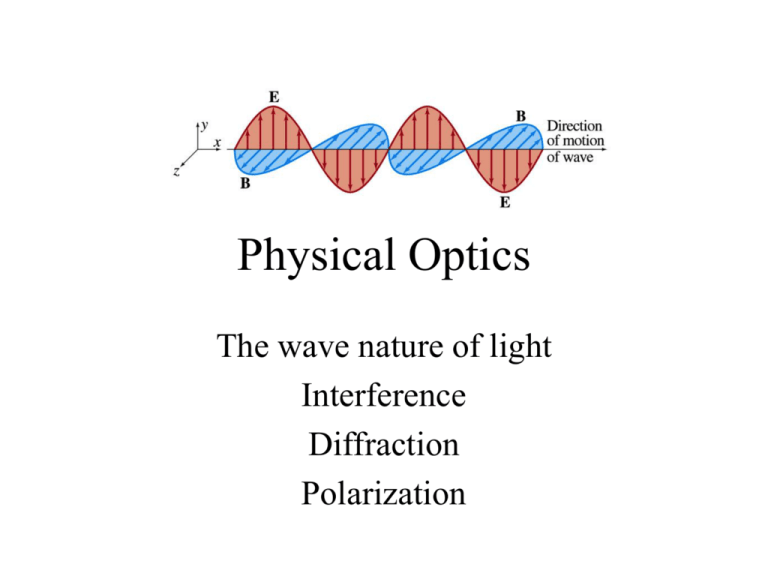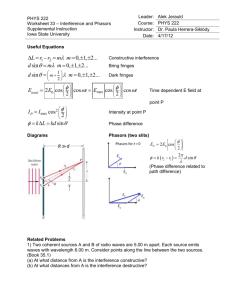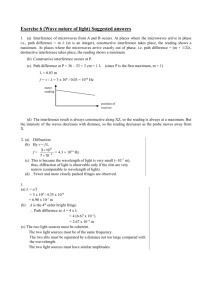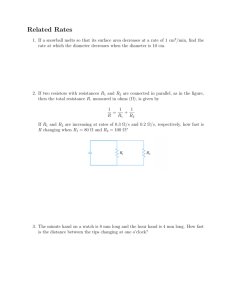Chapter S37
advertisement

Physical Optics The wave nature of light Interference Diffraction Polarization Huygens’ Principle • Every point on a propagating wavefront serves as the source of spherical wavelets, such that the wavelets at sometime later is the envelope of these wavelets. • If a propagating wave has a particular frequency and speed, the secondary wavelets have that same frequency and speed. “Isotropic” Diffraction a • Diffraction – Bending of light into the shadow region • Grimaldi - 17th Century observation of diffraction • Diffraction vs. Refraction? a Explanation of Snell’s Law sin 1 BD v1t AD AD AC v 2 t sin 2 AD AD sin 1 v1t c / n1 sin 2 v 2 t c / n 2 n1 sin 1 n 2 sin 2 Superposition of waves Constructive Interference Destructive Interference Conditions for Interference • To observe interference in light waves, the following two conditions must be met: 1) The sources must be coherent • They must maintain a constant phase with respect to each other 2) The sources should be monochromatic • Monochromatic means they have a single wavelength Young’s Experiment Young’s Experiment Young’s Experiment Maxima occur when: r1 r2 m m 2 S2 m 1 sin m0 d m 1 dsin m m 2 S1 d maxima Minima occur when: 1 r1 r2 m 2 s r2 d S2 S1 r1 r2 r1 s a y 1 d sin m 2 What the pattern looks like Intensity Distribution, Electric Fields • The magnitude of each wave at point P can be found – E1 = Eo sin ωt – E2 = Eo sin (ωt + φ) – Both waves have the same amplitude, Eo φ 2π 2π δ d sin θ λ λ Intensity Distribution, Resultant Field • The magnitude of the resultant electric field comes from the superposition principle – EP = E1+ E2 = Eo[sin ωt + sin (ωt + φ)] • This can also be expressed as AB AB sin A sin B 2sin cos 2 2 φ φ EP 2Eo cos sin ωt 2 2 – EP has the same frequency as the light at the slits – The magnitude of the field is multiplied by the factor 2 cos (φ / 2) Intensity Distribution, Equation • The expression for the intensity comes from the fact that the intensity of a wave is proportional to the square of the resultant electric field magnitude at that point • The intensity therefore is πd sin θ 2 πd I I max cos y I max cos λ λL 2 Resulting Interference Pattern • The light from the two slits forms a visible pattern on a screen • The pattern consists of a series of bright and dark parallel bands called fringes • Constructive interference occurs where a bright fringe occurs • Destructive interference results in a dark fringe Example A He-Ne Laser has a wavelength of 633 nm. Two slits are placed immediately in front of the laser and an interference pattern is observed on a screen 10 m away. If the first bright band is observed 1 cm from the central bright fringe, how far apart are the two slits? At what angle Q is the fourth dark band found? Thin Films Constructive Interference (maxima) d ABC m n o n n Destructive Interference (minima) d ABC 1 m n 2 Chapter 35 - Problem 45 Stealth aircraft are designed to not reflect radar whose wavelength is 2 cm, by using an antireflecting coating. Ignoring any change in wavelength in the coating, estimate its thickness. Phase shift on reflection External Reflection Internal Reflection Now, If one reflection is internal and one reflection is external half wavelength path differences will result in constructive interference Phase Changes Due To Reflection • An electromagnetic wave undergoes a phase change of 180° upon reflection from a medium of higher index of refraction than the one in which it was traveling – Analogous to a pulse on a string reflected from a rigid support Lloyd’s Mirror • An arrangement for producing an interference pattern with a single light source • Waves reach point P either by a direct path or by reflection • The reflected ray can be treated as a ray from the source S’ behind the mirror Lloyd’s Mirror S y a 2 r1 r2 S1 s a sin m m2 Phase shift on reflection s a ym 1 a sin m 2m 1 m a m a 2 2 s Interference in Thin Films Again • • • • Assume the light rays are traveling in air nearly normal to the two surfaces of the film Ray 1 undergoes a phase change of 180° with respect to the incident ray Ray 2, which is reflected from the lower surface, undergoes no phase change with respect to the incident wave For constructive interference =2t = (m + ½)λn (m = 0, 1, 2 …) • This takes into account both the difference in optical path length for the two rays and the 180° phase change • For destructive interference =2t = mλn (m = 0, 1, 2 …) Newton’s Rings o n Maxima - bright 1 2d m m 2 Minima - dark 2dm m Chapter 37 – Problem 62 Show that the radius of the mth dark Newton’s ring as viewed from directly above is given by: o Rm xm n Where R is the radius of curvature of the curved glass surface and is the wavelength of the light used. Assume that the thickness of the air gap is much less than R at all points and that x<<R Newton’s Rings R x R d 2 R Rd 2 x 2 R 2 R d R 2 R 2 d 2 2 Rd 2 d x x 2 d 2 2 Rd 2 Rd Minima 2d m n o x 2m 2 m 2R n o Rm xm n Newtons rings are a special case of Fizeau fringes. They are useful for testing surface accuracy of a lens. o n 2 Maxima o R 1 xm m n 2 Wedges – Fringes of Equal Thickness Minima (destructive) d 2t m m x t x Fringes of this type are also known as Fizeau fringes o n Maxima (constructive) 1 2t m 2 x m 1 m 2 2 x m 2 Example: thin film of air Michelson Interferometer d Compensator Plate • A lens can be used to form fringes of equal inclination (rings) • Tilting the mirrors can cause fringes of equal thickness. • Accurate length measurements are accomplished by fringe counting as one of the mirrors is moved. Detector 2d m d m 2 42. Monochromatic light is beamed into a Michelson interferometer. The movable mirror is displaced 0.382 mm, causing the interferometer pattern to reproduce itself 1 700 times. Determine the wavelength of the light. What color is it? 4.49 107 m 449 nm 5. Young’s double-slit experiment is performed with 589-nm light and a distance of 2.00 m between the slits and the screen. The tenth interference minimum is observed 7.26 mm from the central maximum. Determine the spacing of the slits. 7. Two narrow, parallel slits separated by 0.250 mm are illuminated by green light (λ = 546.1 nm). The interference pattern is observed on a screen 1.20 m away from the plane of the slits. Calculate the distance (a) from the central maximum to the first bright region on either side of the central maximum and (b) between the first and second dark bands. 17. In Figure 37.5, let L = 120 cm and d = 0.250 cm. The slits are illuminated with coherent 600-nm light. Calculate the distance y above the central maximum for which the average intensity on the screen is 75.0% of the maximum. 32. A thin film of oil (n = 1.25) is located on a smooth wet pavement. When viewed perpendicular to the pavement, the film reflects most strongly red light at 640 nm and reflects no blue light at 512 nm. How thick is the oil film? 33. A possible means for making an airplane invisible to radar is to coat the plane with an antireflective polymer. If radar waves have a wavelength of 3.00 cm and the index of refraction of the polymer is n = 1.50, how thick would you make the coating? 37. A beam of 580-nm light passes through two closely spaced glass plates, as shown in Figure P37.37. For what minimum nonzero value of the plate separation d is the transmitted light bright? Mach Zehnder Interferometer Detector • • • • No compensating plate needed Test cell easily inserted in one leg. No factor of two as in the Michelson interferometer. Difficult to align Sagnac Interferometer s r v r v 2 R 2 R 2 R v 4R 2 tcw v c 2 tccw t tcw tccw t t Detector 4R 2 v c 2 8R 8R 2c v 2c v 8R 8R 2c R 2c R 8R 1 1 8R R R t 1 1 2c 1 R 1 R 2c 2c 2c 2c 2c Ring laser gyro. The rotation effectively shortens the path taken by one direction over the other. 8R 2 R 8R 2 t c2 2c 2c 8R 2 ct c Phase Angle i 1 t E E1 E2 E01e i 2 t E02e i t E2 E 2 1 E1 E01 cos 1 E E0 e E02 sin 2 E01 sin 1 tan E02 cos 2 E E01 sin 1 E02 sin 2 E01 cos 1 E02 cos 2 E01 E02 2 E01 E02 cos 2 1 2 2







